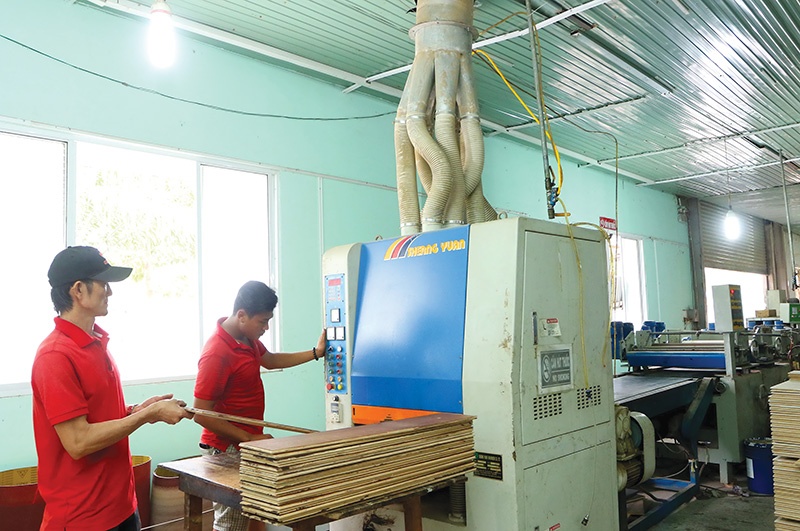Timber groups waking up to change
 |
| It is tough to encourage younger people to choose the timber industry, with so many more options available, photo Le Toan |
The timber and furniture processing industry has set an export target of $20 billion by 2025 and beyond, transforming it into one of the world’s major timber processing centres. Do Xuan Lap, chairman of the Vietnam Timber and Forest Product Association, said that to achieve this goal, “the timber industry will have to find suitable heir in its next generation.”
The entire Vietnamese timber industry has about 5,000 businesses and households investing in the production and processing of wooden furniture for exports.
Lap’s generation makes up the first of the country’s timber processing, and attaches great importance to building a persistent business community in the sector. The second generation has now the opportunity to study abroad and find more attractive professions, leaving many of them unwilling to return to the family business which is further enforced by the inherent requirement for young people to be persistent in the sector.
According to Lap, the achievements of the previous generations are putting pressure on successors. “In the last 10 years, the export value of the industry increased from $3.2 billion to $15.6 billion,” he said.
While previously reluctant to tackle this issue, businesses are now shifting towards taking matters seriously. The government has also begun to pay more attention to this problem, as shown by the fact that the Vietnam Chamber of Commerce and Industry has established the Vietnam Family Business Council since 2014.
Vietnam’s timber industry already has several large family businesses, such as Lam Viet JSC and Thanh Hoa Co., Ltd. The common characteristics of these enterprises are a modern organisational and management structure ensuring transparency and flexibility, professional business processes, and personnel regulations.
The challenge for is now to find a sustainable development direction that is more important than the growth story each year.
The generational transfer, according to Deloitte’s 2019 Global Family Business Survey, includes about 65 per cent of respondents who intended to hand over their business to a family member.
In addition to internal factors that could render the generational shift difficult, Vietnam has signed many free trade agreements with countries and markets with great openness. However, this also comes with increasingly strong competition between domestic and foreign corporations, leaving the new generation with much to cope with.
According to forecasts, timber enterprises will continue to increase their overseas investment expansion. Therefore, the first generation is also at a crossroads when it comes to its general approach – focusing on doing well in the domestic market or going abroad, or both.
Further, the reputation of the family and the business will likely affect the recruitment strategy of senior personnel. Large multinational corporations, when entering the market, already have a reputation, so attracting talent is easy. Meanwhile, young, small family businesses are just in the stage of building prestige and their brands and could face more difficulties in attracting the required human resources.
For many of the family-owned timber businesses, this also means staying flexible and considering more talented people who are not members of their own families.
Johnathan Ooi, partner at PwC Vietnam, said that challenges need to be addressed head-on. “This is an opportunity for Vietnamese businesses to promote the transformation of management models, empower the next generation, and prioritise digital transformation in the next five years,” Ooi emphasised. “Today, business expansion and technology application are the top priority.”
According to Deloitte’s survey, 55 per cent of responding business leaders want to focus on developing new products and services for the market, and 52 per cent said that they will prioritise increasing the application of new technologies.
What the stars mean:
★ Poor ★ ★ Promising ★★★ Good ★★★★ Very good ★★★★★ Exceptional
Related Contents
Latest News
More News
- Takeda supports health resilience amid climate change challenges (December 18, 2025 | 12:39)
- Mondelez Kinh Do - a chapter of purpose-led leadership in Vietnam (December 18, 2025 | 09:44)
- VNPAY services receive the highest-level PCI DSS international security certificates for six consecutive years (December 17, 2025 | 23:47)
- PPL extends its reach into ASEAN (December 17, 2025 | 15:44)
- Over 600 BUV graduates meeting quality benchmarks across triple quality assurance levels (December 17, 2025 | 13:00)
- HEINEKEN Vietnam partners with Ho Chi Minh City Traffic Police on road safety drive (December 17, 2025 | 09:42)
- BUV and China’s CSCSE sign MoU to boost educational cooperation (December 17, 2025 | 08:00)
- PVT Logistics honoured with ‘Fast Enterprise Award’ at APEA 2025 (December 16, 2025 | 18:22)
- Empowering Sustainable Data Centers with Smart Infrastructure Solutions (December 16, 2025 | 13:59)
- Vietjet wins gold ESG transport sustainability award in Taiwan (China) (December 13, 2025 | 22:03)

 Tag:
Tag:






















 Mobile Version
Mobile Version